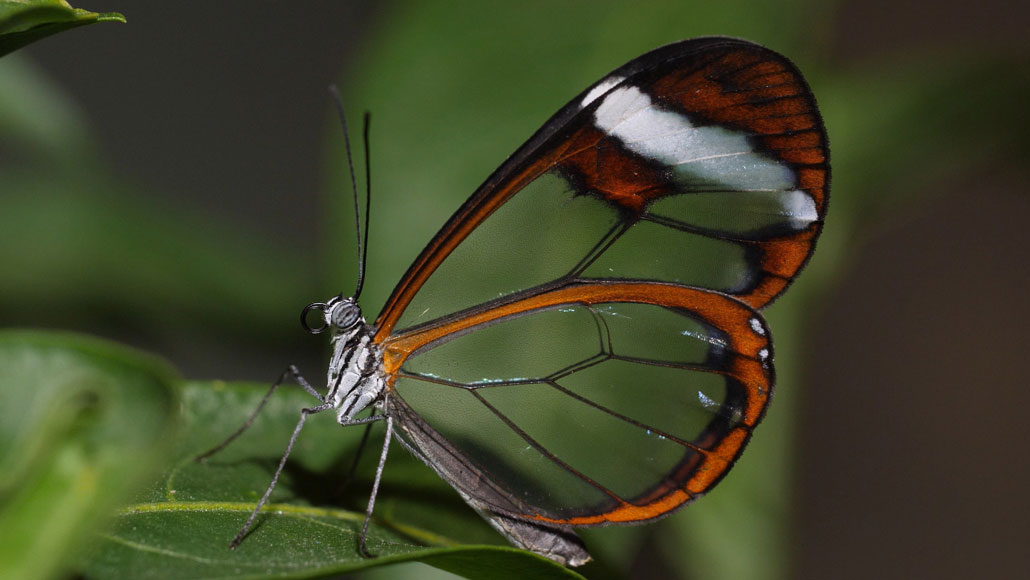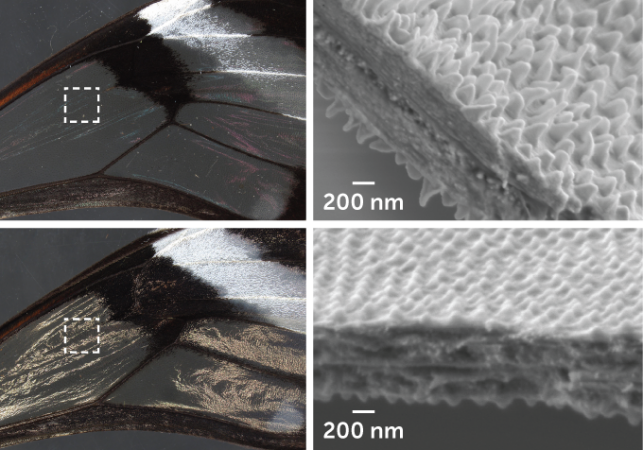Uncovering secrets of the glasswing butterfly’s see-through wings
The tricks of its transparency include sparse, spindly scales and a waxy coated membrane

Glasswing butterflies (one pictured) sport mostly transparent wings. These help the insects hide from predators. New microscope images reveal how we can see through the wings.
A. Pomerantz
Most butterflies sport colorful, eye-catching wings. But some species flit about using mostly transparent wings. Researchers have now uncovered the tricks that one of these — the glasswing butterfly (Greta oto) — uses to hide in plain sight.
Researchers viewed the wings of these Central American butterflies under the microscope. There they spied sparse, spindly scales overlaying a see-through wing membrane. That membrane also has antireflective properties. It’s that combo that makes these insects so stealthy.
Researchers shared what they learned in the May 28 Journal of Experimental Biology.
Being transparent is the ultimate camouflage, says James Barnett. He’s a behavioral ecologist at McMaster University. It’s in Hamilton, Canada. Transparent animals can blend into any background. “It’s really hard to do,” notes Barnett, who did not take part in the work. To limit light reflection, “You have to modify your entire body,” he explains.
Aaron Pomerantz became fascinated by butterflies with transparent wings while working in Peru. “They were really interesting and mysterious,” he says. They were “like these little, invisible jets that glide around in the rainforest.”
This biologist at the University of California, Berkeley, was part of a team that analyzed wings of G. oto using powerful microscopes. They saw that densely packed flat, leaflike scales covered the black rims of those wings. In the transparent areas, narrow, bristle-like scales were spaced farther apart. As a result, only about 2 percent of the underlying clear wing membrane was visible in black regions. Some 80 percent of this membrane was exposed in transparent areas.

“You’d think the simplest solution would be to just not have any scales,” says Nipam Patel. But butterflies need at least some scales in the transparent parts of their wings, explains this coauthor of the study. He is a biologist at the Marine Biological Laboratory in Woods Hole, Mass. By repelling water, he explains, the scales help keep the wings from sticking together when it rains.
The texture of G. oto’s wing membrane also limits glare from the transparent parts. If the membrane’s surface was flat, light traveling through the air would bounce off the wing’s surface. That would cut its transparency, Patel explains. Why? The change in optical properties between the air and the wing would be too abrupt. But an array of tiny wax bumps coats the membrane. This creates a more gradual shift between the optical qualities of the air and wing. And that softens the glare. It lets more light pass through the wing rather than reflecting off of it.
Transparent parts of the glasswing butterfly’s wings naturally reflect only about 2 percent of light, the researchers find. Removing the waxy layer caused the wings to reflect more light — about 2.5 times as much as they normally do.
The new findings may do more than just help biologists better understand how these butterflies hide from predators, Pomerantz says. They also could inspire new antireflective coatings for camera lenses, solar panels and other devices.








